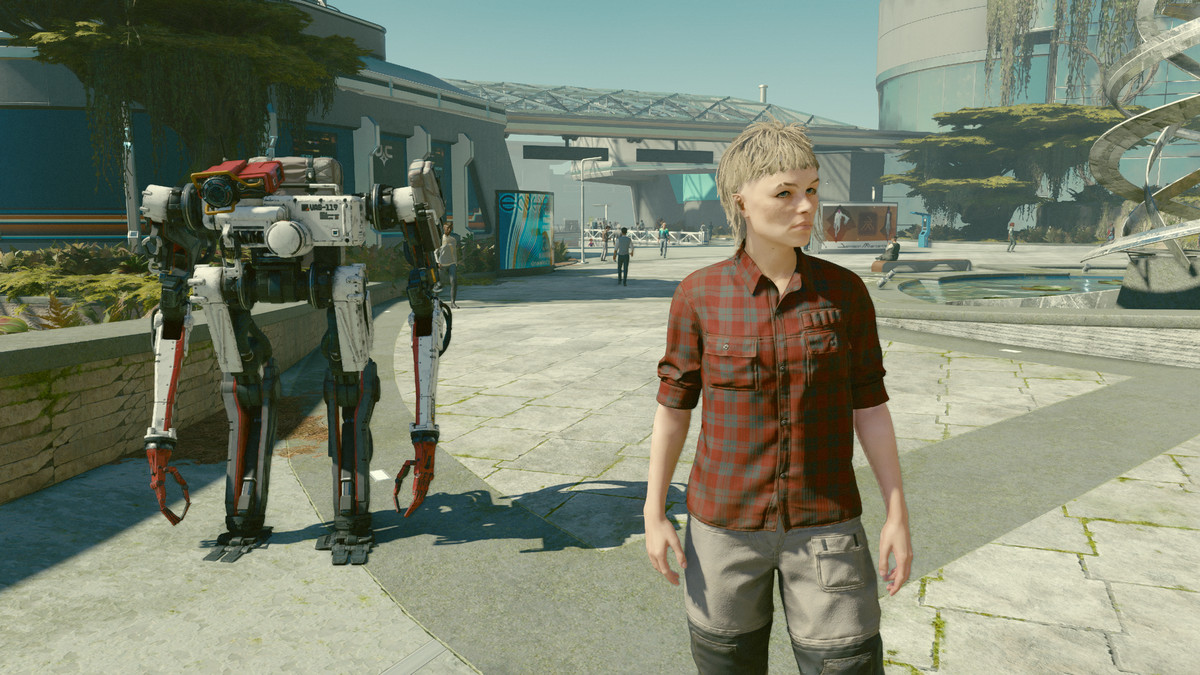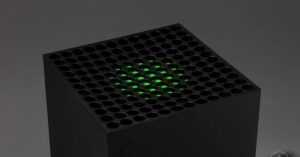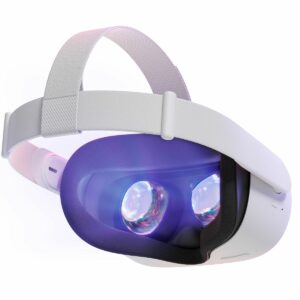If I’ve learned anything from science fiction — and actual science — it’s that space travel is difficult. It requires vast political capital and financial heft to travel through space for even short distances, and exiting a ship to explore a planet means counting out oxygen tanks and accepting that even a small error could result in death. From Outer Wilds to Alien, the best sci-fi stories about space exploration emphasize those stakes — how even in societies where space exploration has become accessible and even normalized, it’s still extraordinarily dangerous.
Except in Starfield, where flying across the galaxy feels about as tricky as doing donuts on a tricycle in my parents’ driveway.
The most obvious illustration of this is Starfield’s emphasis on fast travel, which minimizes the very existence of your spaceship. You also can’t manually land on planets or satellites; instead, you press a button to dock (or, more accurately, you press a button to watch a cutscene of your ship docking, then you press a button to disembark). All of this makes the experience of traveling to mysterious galaxies and hostile planets feel less like riding in the rickety yet powerful Millennium Falcon and more like, say, using the transporter in Star Trek. But Star Trek stories focus on other ways that space travel can be exciting and risky. Starfield, not so much.
Take your spacesuit, for example. In Starfield, it’s equipped automatically. If you want to make it disappear while you’re at an oxygen-rich indoor spaceport, you can press a button in one of the menus to render it invisible. That’s what I’ve chosen to do, since my character fits in better with the game’s NPCs by wearing her space trucker flannel rather than a full helmet and suit — but changing from my flannel back into my spacesuit happens automatically and instantly whenever I get to an airlock. The only thing that does take time is the loading screen while an airlock door opens.

Was it annoying to have to press a button to re-equip my spacesuit and helmet every time I left my ship in Outer Wilds? Yes, it was. But it was annoying in a way that I ultimately found rewarding. The experience of having to remember to put on my suit served to reinforce the hostility of the planets I explored. I had to go out of my way, every time, to protect myself — or else I’d open the airlock and asphyxiate. I made that mistake a handful of times early on in Outer Wilds, and the sense of panic it inspired — as well as that game’s emphasis on refilling your oxygen tank, preventing you from exploring too far from your ship, lest you die — lent significant excitement and danger to the experience of exploring.
Then there’s the matter of fuel. In Starfield, spaceship fuel is infinite, and the only limitation on traveling is how far you can go. Outer Wilds’ ship had infinite fuel, but no fast travel; you had to fly the distances and land on planets manually, which made sense in a smaller-scale game with only a few planets. But also, in Outer Wilds, you had to refill your oxygen tank and jetpack fuel, whereas Starfield’s oxygen tank and jetpack fuel are regenerative. Yet another example of a mechanic being sanded down into something approaching superfluous.
But hey, Starfield isn’t about hardscrabble survival, it’s about exploration, right? Take Metroid as an example, then, since Samus Aran gets infinite oxygen and ammo, as well as plentiful missiles. In order to add friction, though, Metroid makes traversal itself difficult; fast travel is almost never an option, so backtracking and paying careful attention to your surroundings become imperative. In older Metroid games, having to keep track of the location of every save point in enemy-laden environments can add a level of exciting stress that’s tantamount to the best of the Dark Souls series — even with infinite ammo at your fingertips.

What I’m saying is, small frustrations can actually make a video game thrilling, as counterintuitive as that may sound. I don’t want my Starfield spacesuit to be constantly running out of oxygen, nor do I want to asphyxiate because I accidentally fired my weapon at a window. But because I don’t want those things, they should actually happen at some point — or at least I should feel like they could happen, if I’m not careful. The inclusion of inconvenient and even outright dangerous elements makes sci-fi stories about space travel far more exciting. I mean, hell, I had to stop watching For All Mankind because I got so stressed out after the characters brought guns to the moon and shattered the windows of one of their few oxygen-rich outposts. It should feel scary to fire a gun in space! Air is precious out there!
The only points of friction I’ve experienced in Starfield are that I don’t ever seem to have enough digipicks or ammo, and I have to keep an eye on my health bar and my weight limit for carrying items. But here’s the thing about those points of friction: None of them have anything to do with space travel. So why is Starfield even about space travel, given how much of a triviality space travel apparently is when you play the game?
Starfield characters will ask you to visit another planet as though it’s a simple matter of, well, hitting a button. And in Starfield, they’re right. Forgot something on the other side of the galaxy? The worst part of retrieving it will be watching several seconds of loading screens. And that just isn’t a form of friction that I find particularly satisfying.
- SEO Powered Content & PR Distribution. Get Amplified Today.
- PlatoData.Network Vertical Generative Ai. Empower Yourself. Access Here.
- PlatoAiStream. Web3 Intelligence. Knowledge Amplified. Access Here.
- PlatoESG. Automotive / EVs, Carbon, CleanTech, Energy, Environment, Solar, Waste Management. Access Here.
- PlatoHealth. Biotech and Clinical Trials Intelligence. Access Here.
- ChartPrime. Elevate your Trading Game with ChartPrime. Access Here.
- BlockOffsets. Modernizing Environmental Offset Ownership. Access Here.
- Source: https://www.polygon.com/23864881/space-exploration-sci-fi-games-outer-wilds-metroid
- :has
- :is
- :not
- :where
- $UP
- 1
- 220
- 28
- 7
- 8
- 9
- a
- About
- accepting
- accessible
- accurately
- across
- actual
- actually
- add
- After
- AIR
- All
- almost
- also
- an
- and
- Another
- anything
- approaching
- ARE
- AS
- ask
- At
- Atlantis
- attention
- automatically
- back
- bar
- BE
- because
- become
- being
- BEST
- Better
- BOSS
- brought
- but
- button
- by
- CAN
- capital
- careful
- carrying
- changing
- character
- characters
- chosen
- City
- constantly
- could
- counting
- DANGER
- Dangerous
- Dark
- Death
- Die
- difficult
- disappear
- do
- Dock
- does
- doing
- Dont
- Door
- down
- Early
- elements
- else
- emphasis
- emphasize
- enough
- environments
- equipped
- error
- Ether (ETH)
- Even
- EVER
- Every
- example
- Excitement
- exciting
- Exiting
- experience
- experienced
- exploration
- explore
- Explored
- Exploring
- extraordinarily
- eye
- falcon
- far
- FAST
- fast travel
- feel
- few
- Fiction
- financial
- Find
- fingertips
- Fire
- fires
- flying
- Focus
- For
- form
- found
- friction
- from
- Frustrations
- Fuel
- full
- Galaxies
- Galaxy
- game
- Games
- get
- given
- Go
- GUNS
- had
- handful
- happen
- happens
- Have
- having
- Health
- her
- hitting
- How
- http
- HTTPS
- i
- if
- imperative
- in
- in death
- inclusion
- Indoor
- inspired
- instantly
- instead
- into
- IT
- items
- itself
- jpg
- just
- Keep
- Land
- learned
- least
- left
- less
- Level
- like
- LIMIT
- limitation
- loading
- location
- made
- make
- MAKES
- manually
- Matter
- May..
- mean
- means
- Millennium
- minimizes
- missiles
- mistake
- Moon
- more
- most
- much
- my
- mysterious
- never
- New
- Newsletter
- no
- None
- nor
- Notes
- obvious
- of
- older
- on
- ONE
- only
- open
- opens
- Option
- or
- order
- Other
- out
- Oxygen
- Panic
- part
- particularly
- Patch
- patch notes
- paying
- perspective
- planet
- Planets
- plato
- Plato Data Intelligence
- PlatoData
- Play
- player
- Point
- points
- political
- Polygon
- powerful
- Precious
- press
- preventing
- Prime
- protect
- put
- rather
- Red
- regenerative
- reinforce
- remastered
- requires
- result
- Retro
- rewarding
- riding
- right
- Risky
- robot
- roundup
- running
- safe
- satellites
- Save
- say
- saying
- sci-fi
- Science
- Science Fiction
- Screen
- screens
- seconds
- seem
- sense
- Series
- several
- Short
- should
- side
- sign
- significant
- Simple
- since
- small
- So
- some
- something
- Sound
- Space
- space exploration
- Space Travel
- Spaceport
- Star
- Star Trek
- Starfield
- Still
- Stop
- Stories
- stress
- Suit
- survival
- Take
- tank
- Tanks
- than
- that
- The
- their
- Them
- then
- they
- thing
- things
- this
- those
- though?
- thrilling
- Through
- time
- times
- to
- together
- too
- track
- travel
- Traveling
- Ultimately
- using
- Vast
- very
- via
- Video
- video game
- Visit
- W3
- want
- was
- Watch
- watching
- Way..
- ways
- webp
- weekly
- weight
- WELL
- What
- when
- whenever
- whereas
- which
- while
- why
- will
- window
- windows
- with
- Worst
- XML
- yes
- yet
- you
- Your
- zephyrnet













